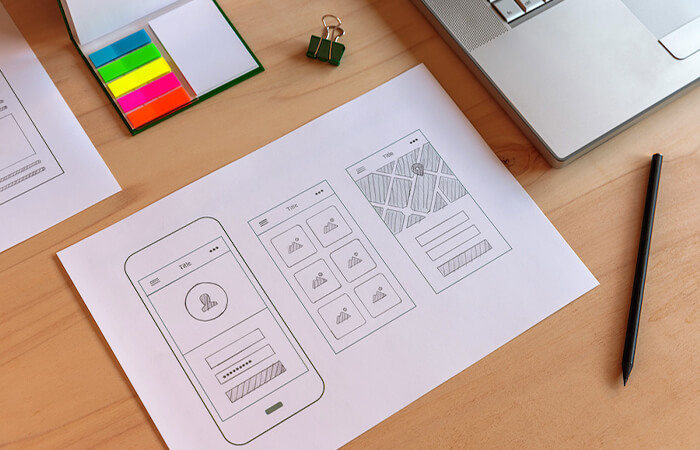The tech industry is solution-based, with most developers losing sleep over app creation. It wouldn’t be wrong to say that launching a mobile app now will be the best time to do so. This trend has become the driving force behind businesses rolling out customized applications.
As a result, the mobile app market is expected to hit $437.80 billion later this year. But, beyond the profit potential, there’s a chance to solve issues your customers have. It’s easy to find reasons for creation, but it doesn’t provide solutions on how to validate your mobile app idea.
In truth, you could have the resources and plans down to the last detail. But, that doesn’t stop doubt about the product’s efficiency from creeping in. Additionally, you’ll have to contend with competitors with similar products already.
But fret not; we’ve written this blog to douse your raging flames of worry. You’ll learn how to plan your mobile app idea validation process and make adjustments. Ultimately, you’re bound to uncover a new business idea to build into an asset.
Let’s begin
The Importance of Idea Validation

The concept of idea validation is a rather peculiar one. For average mobile app developers, the mobile app development process follows a clear pattern. It involves getting the right tools, building an excellent code, and launching a new asset.
The mobile app development process, although simplified, is easy to follow as it’s more hands-on. There’s hardly any time spent on brain-wracking work which won’t create the app.
Eliminating the idea analysis won’t work in this highly competitive business world. You could be so sure of your creation but end up with a dud.
That’s why you need to validate your app idea. It’s an opportunity to research your most profitable mobile app ideas before spending. After all, app development costs can run from $40,000 up to $300,000.
Idea validation justifies what you’ve decided to create. If it gets neglected, you will end up with unhappy customers. This outcome is worth avoiding.
8 Key Steps on How to Validate Your Mobile App Idea
Are you looking for answers to the question “how to validate your mobile app idea”? If so, look no further.
We’ve done our research on the best proof techniques. Through our analysis, a short guide for assessing your idea came up. This process will help you avoid any issues down the road after the app’s completion.
1. Kick-Off With a Little Market Research

This stage is the exact moment when you become an explorer. Despite having an excellent creation plan, market research is crucial for ultimate success. It’s a chance to look beyond your industry’s safety and see what’s in store. To get started, follow this discovery process;
Identify The Purpose of Your Research
It would be best if you determined the intention of your market research. It helps to scope out what matters to your business. For top brands, the intent links to the creation of solutions. Findings and analysis lead to making life easier for customers.
For a practical example, look at companies like Uber, Facebook, and Airbnb. Their mobile apps have a build that helps clients out. You can use these specs as a guideline for what you’re trying to create.
Of course, it would be different depending on the industry, but it operates on the same principle, “Making life easier.”
If your app is going for a problem-solving angle, you should also answer these questions;
- Would you use the app you’re trying to create?
- If you won’t use the app, what are its limitations?
- Are there similar apps already in use?
- Is your app capable of using new methods to solve an old problem?
These queries should give you a solid base for launching the review process.
Identify Your Target Audience Segment
This section is where things start to get trimmed. You already have an existing target audience for your business, and that’s a good thing. It’s time to look deeper. The app idea might not benefit all clients the same way.
Think about it: you run a business in the fashion industry. You could mean your creation for clients needing clothing materials and not actual clothes.
That way, you’ve found the perfect niche to push your app ideas to startups. This discovery doesn’t mean a section of your target audience is left out. You’re just giving priority to those who need it.
Do Competitor Analysis
You’re not alone in the race to develop app ideas to solve problems. Rival businesses in the same industry might have already had similar products in the works. In some cases, similarities could extend to names and operational models.
Competitors’ analysis is vital in staying ahead. First, it lets you look at what your rivals are building. Then, you can use that information to improve your idea.
If they already have a product out on the market, even better. You can make a new and improved version of it. This model will be fixing the bugs your competitors have, so you’re in the lead.
Make an Action Plan
Having all your processes mapped out can be beautiful but won’t have aesthetic appeal if you don’t implement them. Making an action plan will launch the implementation process. For example, creating a timeline for product completion.
When creating the plan, it’s vital to have some wiggle room. This extra space lets you plan for unforeseen circumstances and make changes on the go.
2. Identify your Target Audience and Size

This step is vital if you combine a business launch and app development. It’s key to figure out the average customer base expected to benefit from what you’re making. There are no medals to be won by trying to satisfy customers that are already content.
To simplify the process, you can narrow it down using the following metrics;
- What gender is your app targeting?
- How much is the disposable income available to your customers?
- What is the approximate age group of your customers?
- What marketing strategy do they respond to best?
- What are the expectations of your audience while using the app?
3. Analyze the Problems Your Audience is Facing

A crucial part of your business is knowing customer issues. You become a doctor of products and services, asking your clients where it hurts. However, it would help if you also consider that your customers might have tried to solve the problem themselves.
Unfortunately, they don’t have the right tools, making it futile and stressful. Now, it’s you who they have come to get their problems fixed. You’re in a win-win situation if you provide them with the right solution.
4. Examine How Your App Solves Their Problems
The source of your customers’ issues is of little consequence. It could happen because they use rival products. This situation isn’t one to be happy out if you have no solution for them. Instead, take it as a controlled experiment for the app idea you’re examining.
The customer’s problem will pop up on your radar. There might be a timing delay, but it’s an absolute certainty. You can prepare for it by reviewing how your idea can make life easier for them.
It’s a shoo-in if it can reduce stress or automate a process. Else, you’re heading back to the drawing board.
5. Create a Minimal Viable Product (MVP)

You’ve done your research and gotten your audience past the first four points. The next stage is creating a minimum viable product (MVP). This mobile app prototype is a version of what you’re trying to make.
That said, the MVP is a fully functional model. Its purpose for creation is for use as a testing base performance. Only the key solution features that the main app has should be part of this version. It ensures you don’t lose money and time on developing unnecessary characteristics.
It might look like a time-waster, but it pays off nicely. By sending the MVP out, you’ll get direct access to feedback on the main product. In addition, you can put it out on social media to get a widespread opinion base.
It’s also best to brace yourself because the reviews might be brutal. But, it’s a small price to learn if you have a valid app idea.
You Might Also Find This Interesting 15 Best Mobile App Ideas to Skyrocket Revenue In 2022
6. Analyze the Competition in Your Niche

You have the perfect solution in mind but so do your competitors. It’s your job to be an elite stalker focused on learning about rival marketing and objectives. To get this done, closely examine their methods of audience reach.
The channels of marketing will vary depending on the company. That said, it’s a certainty they’re making use of websites and social media. You can analyze their tool use to determine how effective their business model and the solution delivery are.
If you’d prefer a solid tech solution, the tools are yours. Platforms like Alexa, Ahrefs, and Similar Web are perfect for letting you know how competitors perform.
To assess the success rate of competitor apps, look at their reviews. It doesn’t get any more honest than a customer with a first-hand experience. The best part is the group being studied can’t forge the reviews.
Brands are more focused on getting issues fixed than just looking good. This decision makes them vulnerable to screening from rivals, i.e., YOU.
7. Map out the Customer Journey

In truth, idea validation is for your benefit. It’s convincing that you need it. This fact doesn’t change even if the app is for customers. So, it’s to be more considerate about the customers’ experience. The best way to get this done is to understand the customer’s app journey.
The journey in question includes the experiences the user would go through. Developing this new perspective is vital as app ideas fail when creators have tunnel vision.
This limited view will result in the creation of a subpar product. On the other hand, understanding the user’s journey gives directives on setting up the design process for the app.
Get Users’ Perspectives
As before, you should answer a set of questions to get users’ perspectives about your mobile app. These are;
- Would users pick this app over that of competitors?
- What features does the app have for solving customers’ problems?
- How long does it take for a user to find a solution?
- What can attract users to my app?
- On a scale of 1-10, is customer support easily accessible?
These queries are perfect for letting you know the app’s probability of solving issues. Also, you learn how long it takes for solutions to be generated. That information can be used to decide on the most effective app features.
While considering the customer’s journey, don’t overlook emotions and motivations. These are the secret forces that influence the customer’s interaction level.
While using your app, the customer is in a constant state of cause and effect. This situation will let you know when the driving force is a pain point. Having this information will help you smooth things over with the right content.
Even though the map is complete, most of it remains theoretical. That’s why you should try it out yourself. Honestly, there’s no point in rolling out an app you won’t consider using.
Go through your app’s features personally and see how it all works. If you’re not satisfied with the current state, neither will the customer. So make the improvements that you feel would help you as a user.
8. Take Reviews from your Customers

This process is most effective using existing customers. These individuals have already experienced your products/services. If there’s an issue with your business operations, they’ve felt it. You can also bank on their honesty as they’d appreciate sales interactions getting better.
For your app ideas to solve problems, run it by your clients. They stand to benefit the most and can provide insight into the solution potential of the app. Additionally, you can use the reviews to focus on app features to give quick solutions.
Final Thoughts
Congratulations on coming up with an app idea that solves problems. It’s not an easy task, and it’s easy to think your idea will fail. You can use this blog to assess the success potential of your app.
There’s also a chance you’ve gone through and realized the idea isn’t great. Therefore, having an expert opinion by your side is always a good idea. This Additionally, hiring a reliable mobile app development company in Dubai can save you big time from the time spent and money spent on your mobile app.
TechNerds is a top-rated North American mobile app development company that employs expert mobile app developers. We mix up the latest tech and development best practices to bring your mobile app idea to life.

So, before you begin working on your app idea, discuss it with our experts to ensure it becomes a market-fit product. After all, the only bad idea is one that creates problems.

